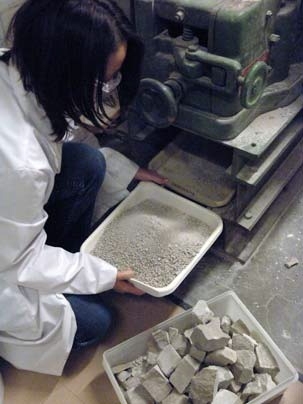Even though they are among the best-known structures on Earth, the pyramids of Egypt may still hold surprises. This spring, an MIT class is testing a controversial theory that some of the giant blocks that make up the great pyramids of Giza may have been cast in place from concrete, rather than quarried and moved into position.
In order to help identify blocks that were cast rather than quarried, students in the class, Materials in Human Experience (class 3.094), are assembling a small pyramid using a combination of both kinds of material. They will then use techniques such as microscopic imagery and chemical analysis to look for signs that might provide ways of telling the difference on samples from the Great Pyramid itself.
While many people think of concrete as a recent material, in fact the Romans used a version made from volcanic ash and lime extensively for most of their famous buildings, including the Pantheon. But although the idea that the Egyptians may have used a kind of concrete in building the pyramids was first suggested in the 1930s, with a specific material that could have been used proposed in 1988, so far there has been no proof and the idea has remained mired in controversy.
Contentious subject
In fact, the very idea has been so controversial that "you can't get research funding, and it's difficult to get a paper through peer review," says Linn Hobbs, professor of materials science and engineering and professor of nuclear science and engineering at MIT and coteacher of the pyramid-building class.
Hobbs says that actually building a small-scale model of the pyramid using the materials and methods the Egyptians may have used is far more than just an educational exercise for the students. "Like any other investigation of ancient technologies, you can only get so far by speculating, and even only so far by looking at evidence. To go the rest of the way, you have to do the thing yourself. You have to get acquainted with the materials."
Speculating on materials
The materials and know-how needed to cast the pyramids' giant 2-1/2 ton blocks in place, rather than quarrying and moving blocks of solid limestone, was definitely available to the Egyptians, Hobbs explains. At least 90 percent of the material would have consisted of powdered limestone, and Egyptian limestone is especially fragile and can easily be reduced to finely divided sludge simply by soaking it in water. The rest--the binder or cement--could have been made from materials they were known to have had and used for other purposes.
The binder, known as a geopolymer, could have been made from lime, kaolinite (a kind of clay), a fine silica (such as diatomaceous earth) and natron (sodium carbonate). The same ingredients were used by the Egyptians to make self-glazing pottery ornaments, a material called Egyptian faience, and well known to archeologists. When fired at high temperature, the material produces a rich blue glaze on the surface. But if left for days or weeks at room temperature, it self-cures into a rock-hard material that could have provided a binder for cementing the disaggregated limestone together into cast blocks.
Hobbs suggests that some ancient craftsman may have inadvertently left some faience material unfired, and discovered by accident the hard material that resulted. In building pyramids, especially the higher layers as the structure grew, casting blocks in place would have been a far easier task than carving them to precise sizes and shapes and then moving them up long earthen ramps into their final positions -- a process that has never been described or pictured in any of the vast number of Egyptian texts and murals that have been found.
Like Silly Putty and Jell-O
While wet, the consistency of the material is quite different from modern Portland cement, Hobbs says. "It's like something between mortar and Jell-O. When you try to pack it, it kind of ripples," he says. "It's rather like Silly Putty."
But the unusual material has a significant advantage: It doesn't shrink when it sets. "With most cements, you worry about shrinkage," Hobbs says, but not with this kind.
The class has been experimenting with different proportions and variations in ingredients for the geopolymer, to see which produces the strongest, most durable and limestone-like results. "This is not a cookbook class," Hobbs explains--he and the students are figuring things out as they go along.
An agnostic in search of answers
Hobbs is not pushing the cast-block theory, which was first advanced by French materials chemist Joseph Davidovits, who invented (or perhaps reinvented) the geopolymer formula. Hobbs calls himself an agnostic on the matter, but thinks that it is a theory that deserves serious study and investigation.
"My own take is, they probably did both--cut some and cast some," he says.
"It's not science unless we formulate hypotheses that can be proved or disproved," he says. He hopes the class will produce a scientific paper detailing how the question could be resolved more definitively through microscopic and microchemical analysis. "It's good that the students can see a real scientific controversy being addressed in productive ways."
A version of this article appeared in MIT Tech Talk on April 2, 2008 (download PDF).







